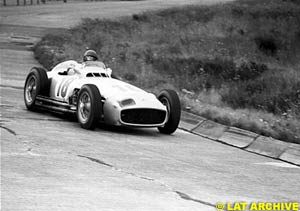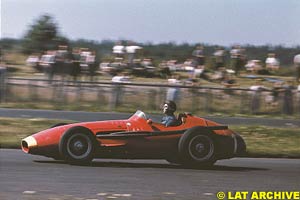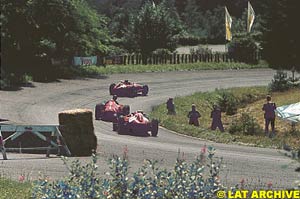
Atlas F1 Magazine Writer
The 1957 German Grand Prix will go down in Formula One history as one of the true legends of the sport. There's only one man responsible for that and that's Juan Manuel Fangio. On that hot August day, the Argentine wrote history on the track he loved most. However, 1957 wasn't his only time on The Ring. This time we'll take a look at five magical performances in the Eifel mountains.
Unfortunately Pietsch shot off the track just before completing his second lap and subsequently the battle was two Alfas vs four Ferraris. After five laps Ascari overtook Fangio and a lap later the Argentine headed for the pits to get his car refuelled. As the three leading cars had already built a substantial lead over the rest of the field, this only dropped Fangio to third. Not much later, Fangio faced the challenge of trying to beat four Ferraris all on his own, as Farina retired with an overheating engine. Just prior to half distance, Ascari made his only pitstop, handing Gonzalez the lead, but coming back on the track ahead of Fangio. That wouldn't last long, though. Fangio, on a two-stop strategy, was now much lighter than Ascari and as Gonzalez made his stop, the Argentine overtook Ascari and thus moved back in the lead. Now it was his task to build his lead large enough to make a safe second stop.
He managed to strike a gap, but as he moved in for fuel after 14 laps, it proved not to be enough and Ascari regained the lead and thus a certain victory. However, it all seemed to go up in smoke as Ascari came into the pits in the dying stages of the race. His tyres were causing him trouble and needed looking after. While everyone was expecting Fangio to blast past any second, Ascari was back out of the pit before the Alfa arrived, keeping the lead. When Fangio came by, it was obvious that he was going slower than before and an imminent retirement was feared. However, with Gonzalez now far back, Fangio could take it easy without endangering second place and when the flag dropped that was his reward. All in all, Fangio was wise to settle for second, as it increased his lead in the Championship to ten points, with Ascari now being his closest follower.
As the race started, it wasn't one of the three Ferraris going into the lead, but it was Fangio in his Maserati. Sadly for Fangio, his lead was short lived and Ascari passed him before the first lap was over. What followed was a display of massive domination by Alberto Ascari. The Ferrari driver increased his lead by some ten seconds a lap, while Fangio dropped to third behind Hawthorn. As the cars crossed the line for the fourth time, Ascari was nearly 40 seconds ahead of his pursuers. However, then it all started to go wrong for Ascari. The Italian lost a wheel and carefully limped into the pits, while Hawthorn and Fangio went past with little between them. A long way behind them was Farina in third, but the 1950 champion suddenly starting pushing his Ferrari beyond the limit and in no time was all over the two leaders. Before they knew what had happened, Farina was into the lead and away.
Fangio kept his cool and in all the confusion managed to pass Hawthorn to keep his second place. Even though Ascari was making his way back up the rankings and even switched to Villoresi's car ahead of him, it wasn't meant to be the World Champion's day. While having visual contact with Hawthorn ahead of him, his engine failed and the podium remained as it had been throughout the second half of the race: Farina won, ahead of Fangio and Hawthorn.
1954 saw Fangio at The Ring in yet another car. This season was the triumphant return of Mercedes to the racing elite. In practice, Fangio showed that the Mercedes power and his love for the Nurburgring went together very well, as he recorded a time of 9:50.1, beating Hermann Lang's 1939 record of 9:52.2. Only Ferrari's Mike Hawthorn could stay close, a little over three seconds behind. Third was Stirling Moss in a Maserati, a massive 10.6 seconds behind the polesitter. However, the pole didn't bring any joy at all. During second practice, Fangio's countryman and protege Onofre Marimon crashed and died on the spot.
The following year, there was no German Grand Prix. It was one of the events that had been cancelled after a crash at Le Mans had killed 55 spectators. For 1956, the circus came back to The Ring, Fangio now driving for the team that had been his biggest rival throughout the years, Ferrari. Practice showed sheer domination by the Lancia-Ferraris, as Fangio grabbed pole in 9:51.2, slightly ahead of Peter Collins and Eugenio Castellotti. Stirling Moss in the Maserati completed the first row, over 12 seconds behind Fangio.
To illustrate the achievement of Fangio, Collins and Castellotti even better, fellow Ferrari driver Luigi Musso, only just returning from a heavy injury, was placed fifth no less than 29 seconds behind his team leader. The race then became a true battlefield as only seven reached the finish, of which one wasn't classified (privateer Ottorino Volonterio) and one was disqualified (Bruce Halford). Fangio led from start to finish, demolishing the lap record time and time again, eventually ending up setting it at 9:41.6, nearly ten seconds faster than pole position! Moss was the only one who could more or less follow, ending the race 'just' 46 seconds behind the winner. Frenchman Jean Behra came third, albeit over seven and a half minutes behind Fangio.
In 1957 Fangio returned to the Green Hell for one final time, now back with Maserati. Practice already lay the foundation of things to come as the lap record was shattered in a way rarely seen before or after. Fangio put his Maserati on pole in a time of 9:25.6, taking a massive 15 seconds off the lap record! However, it wasn't just Fangio who was so incredibly fast. No less than seven drivers went faster than Fangio's fastest lap of the previous season. Before the race, the Maserati team decided to do a mid-race pitstop for fresh rubber and refuelling, while Ferrari opted to go for a non-stop affair. This meant that Fangio had to built a sufficient lead in the early part of the race in order to stay ahead of the Prancing Horses. After his tyres had gotten up to temperature, Fangio set off to perform the task at hand.
Collins came back, but Fangio moved ahead a second time. While doing this, a rock shot from under his wheel and destroyed Collins goggles, eliminating the Ferrari driver from the battle. The old master set after Hawthorn and grabbed the lead halfway through the final lap. The Argentine took his final win by 3.6 seconds, scoring his fifth World Championship. Juan Manuel Fangio couldn't have said it better when he said, "Without any doubt, the Nurburgring was my favourite circuit. I loved it, all of it, and I think that day I conquered it."
Both the Nurburgring and Juan Manuel Fangio will always stand out as legends of the sport and the combination of both produced nothing more than sheer magic, which deserves to be remembered by anyone and everyone.
Even though Fangio was far from a rookie in 1951, he encountered the Green Hell just days before he had to drive his first race there. The Argentine came to Germany leading the Championship with 21 points, followed by Giuseppe Farina with 15 and Luigi Villoresi with 12. In order to get to know the track, Fangio explored it driving an Alfa Romeo road car. He loved it right away and it showed in practice. The Ferraris of Alberto Ascari and Froilan Gonzalez were especially fast on the long and mountainous track and thus they occupied the first two positions on the front row. Together with Ascari and Gonzalez, there was one more driver to qualify in less than ten minutes and that was Juan Manuel Fangio.
 So the race started with two Ferraris and two Alfas on the front row, Farina taking the fourth spot. Farina was fastest off the grid and into the first left hander, but going back to the right into the Sudkurve, Fangio put his Alfa ahead of his teammate. Soon Ascari and Gonzalez followed his example. After lap one, Fangio led Ascari, Gonzalez and Farina. Paul Pietsch, the only German driver, followed in the third Alfa, with Piero Taruffi and Luigi Villoresi behind him in their Ferraris.
So the race started with two Ferraris and two Alfas on the front row, Farina taking the fourth spot. Farina was fastest off the grid and into the first left hander, but going back to the right into the Sudkurve, Fangio put his Alfa ahead of his teammate. Soon Ascari and Gonzalez followed his example. After lap one, Fangio led Ascari, Gonzalez and Farina. Paul Pietsch, the only German driver, followed in the third Alfa, with Piero Taruffi and Luigi Villoresi behind him in their Ferraris.
 In 1952 Fangio was nowhere to be seen at the German Grand Prix, as he was recovering from a huge crash in the Monza Grand Prix in early June. The next year, he was back. This time in no position to win the Championship as Ascari was light years ahead of the rest. Again the Ferraris were the cars to beat, as Ascari led the Championship ahead of young gun Mike Hawthorn. They were followed by the two Maseratis of Gonzalez and Fangio, who were now teamed up after Alfa withdrew from racing following the 1951 season. This time, Ascari was the only driver able to lap the circuit in less than ten minutes, but Fangio proved to be the best of the rest, claiming second on the grid as the only non-Ferrari on the front row.
In 1952 Fangio was nowhere to be seen at the German Grand Prix, as he was recovering from a huge crash in the Monza Grand Prix in early June. The next year, he was back. This time in no position to win the Championship as Ascari was light years ahead of the rest. Again the Ferraris were the cars to beat, as Ascari led the Championship ahead of young gun Mike Hawthorn. They were followed by the two Maseratis of Gonzalez and Fangio, who were now teamed up after Alfa withdrew from racing following the 1951 season. This time, Ascari was the only driver able to lap the circuit in less than ten minutes, but Fangio proved to be the best of the rest, claiming second on the grid as the only non-Ferrari on the front row.
 His death was a terrible shock for Fangio and he didn't want to race. Team manager Alfred Neubauer convinced him that it was better to race than to keep mourning and Fangio gave in. Struck by grief over their killed countryman, Fangio and Gonzalez went all out in the race. First Gonzalez went into the lead, but before the end of the first lap Fangio overtook him and quickly moved away. When it became clear that Fangio was unbeatable, Gonzalez's mourning took over from his will to win and the Pampas Bull slowly dropped back. Only fellow Mercedes driver Karl Kling could match Fangio's times and prior to pitting, the German even led the race briefly. However, when he pitted, Fangio took over again, winning by over a minute.
His death was a terrible shock for Fangio and he didn't want to race. Team manager Alfred Neubauer convinced him that it was better to race than to keep mourning and Fangio gave in. Struck by grief over their killed countryman, Fangio and Gonzalez went all out in the race. First Gonzalez went into the lead, but before the end of the first lap Fangio overtook him and quickly moved away. When it became clear that Fangio was unbeatable, Gonzalez's mourning took over from his will to win and the Pampas Bull slowly dropped back. Only fellow Mercedes driver Karl Kling could match Fangio's times and prior to pitting, the German even led the race briefly. However, when he pitted, Fangio took over again, winning by over a minute.
 What followed was a truly marvellous display of car control. Fangio kept pounding out record laps one after the other, leaving the entire field behind in awe. Once the time to stop had come, after 12 laps, his lead was 28 seconds. It had been calculated that he'd need a 30-second gap to stay ahead, so things were going to be quite close. However, things got less than close when the Maserati crew messed up the pitstop, taking 56 seconds to get Fangio out on the track again. On his first lap out of the pits, Fangio again took the time to get his tyres to the right temperature and after 14 of the 22 laps, he was 48 seconds behind. That one slow lap fooled the leading duo of Hawthorn and Collins into believing Fangio was in trouble. However, nothing was further from the truth. Fangio took up where he had left off and broke the lap record again and again, taking five to seven seconds off the lead each lap. With two laps to go, Fangio was now only three seconds away from the lead, as everyone at Ferrari were looking very much horrified by what had happened. The next lap saw the three coming past the pits right behind each other, Hawthorn still leading with Collins slightly ahead of Fangio. Then, on the final lap, Fangio made his move past Collins.
What followed was a truly marvellous display of car control. Fangio kept pounding out record laps one after the other, leaving the entire field behind in awe. Once the time to stop had come, after 12 laps, his lead was 28 seconds. It had been calculated that he'd need a 30-second gap to stay ahead, so things were going to be quite close. However, things got less than close when the Maserati crew messed up the pitstop, taking 56 seconds to get Fangio out on the track again. On his first lap out of the pits, Fangio again took the time to get his tyres to the right temperature and after 14 of the 22 laps, he was 48 seconds behind. That one slow lap fooled the leading duo of Hawthorn and Collins into believing Fangio was in trouble. However, nothing was further from the truth. Fangio took up where he had left off and broke the lap record again and again, taking five to seven seconds off the lead each lap. With two laps to go, Fangio was now only three seconds away from the lead, as everyone at Ferrari were looking very much horrified by what had happened. The next lap saw the three coming past the pits right behind each other, Hawthorn still leading with Collins slightly ahead of Fangio. Then, on the final lap, Fangio made his move past Collins.
Please Contact Us for permission to republish this or any other material from Atlas F1.
|
Volume 7, Issue 25
Atlas F1 Special
Montoya's Pendulum:
from Hero to Zero
The 2001 Mid-Term Report
Unrealistic Expectations
Team Connaught Part II: Remembrance of Things Fast
European GP Preview
The European GP Preview
Technical Preview: Nurburgring
Focus: Fangio at the Nurburgring
Columns
Elsewhere in Racing
The European GP Trivia Quiz
F1 DVD Review
Bookworm Critique
Rear View Mirror
The Weekly Grapevine
> Homepage |